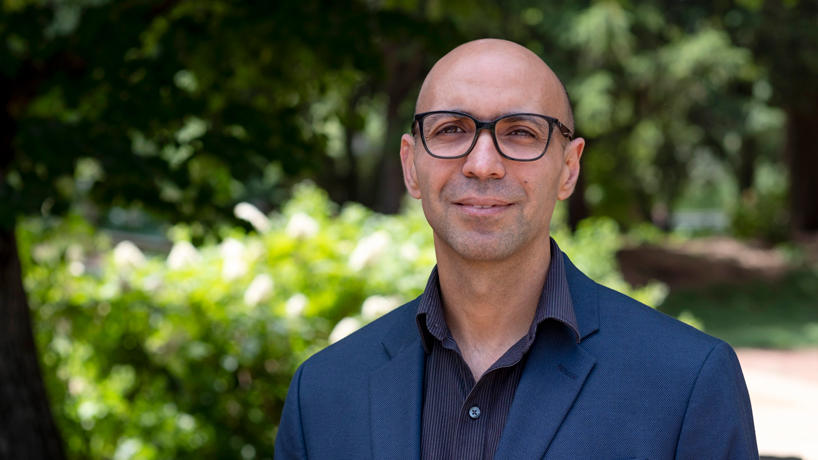
UMSL Assistant Professor Abderrahmen Mtibaa is part of a team of researchers working to solve networking and security challenges that hinder public safety and disaster response. (Photo by August Jennewein)
The police response to the deadly May 24 shooting at Robb Elementary School in Uvalde, Texas, has been heavily scrutinized since it was learned that the shooter remained in the school for more than an hour before finally being killed by members of the United States Border Patrol Tactical Unit.
The decision not to confront him more quickly has been attributed to the mistaken belief by Uvalde School District Police Chief Pedro Arredondo that the situation had transitioned from an active shooter to a barricaded subject and that no more children were at risk, according to Texas Department of Public Safety Director Steven C. McCraw.
Abderrahmen Mtibaa, an assistant professor of computer science at the University of Missouri–St. Louis, wonders if things might have played out differently had law enforcement officers on the scene had easier access to the school’s network infrastructure, including the cameras and motion sensors, that would have allowed them to see inside the classroom as the standoff was unfolding.
Or if more lives could be saved in another emergency scenario – maybe a tornado or an earthquake, where communication can be intermittent or unavailable – if first responders are able to access networked devices already on site to help locate victims so they can deliver aid.
Mtibaa is part of five-person research team, led by New Mexico State University Professor Satyajayant Misra, working to solve networking and security challenges that hinder public safety and disaster response. They hope to create a way for first responders and other Good Samaritans to be able to temporarily gain access to technology tools available in disaster scenarios, even when the infrastructure might not be functioning as normal and while not jeopardizing the security of the networks the devices are connected to.
The National Science Foundation awarded them a three-year, $1 million grant to support a project titled “RINGS: Resilient Edge Ecosystem for Collaborative and Trustworthy Disaster Response (REsCue).”
“When you work in natural disaster or disaster recovery, you’re going to really need to take actions very quickly without really getting access to these things,” Mtibaa said. “So you need to really have what we call zero-trust access control. You have no trust at all in these persons, and then you need to allow them access. Of course, how can you do it with maintaining some level of security, accountability, everything? That’s what we are really working on and what we are interested in.”
Mtibaa is working with some of his former colleagues at New Mexico State – where he worked from 2017 to 2019 before coming to UMSL. Among them are Misra as well as Reza Tourani, a former New Mexico State PhD student who is now an assistant professor of computer science at Saint Louis University. They have been collaborating on related research since 2017.
The team was one of 37 research groups to receive funding from NSF as part of a $37 million public-private partnership called the Resilient and Intelligent Next Generation Systems, or RINGS, program. RINGS is focused on accelerating research in the areas of wireless and mobile communication, networking, sensing, computing systems and global-scale services, and NSF has been working with industry partners such as Apple, Ericsson, Google, IBM, Intel, Microsoft, Nokia, Qualcomm and VMware.
“The fact that the project got accepted, that’s proof to us that what we are doing is not simply cutting-edge research or work,” Mtibaa said. “It’s also applicable and it’s of an interest to real-world application or companies.”
Mtibaa will be primarily focused on integrating autonomous networks into a cooperative “network of networks” and ensuring its resilience during periods of disruption.
The project is also focused on ensuring security because there are ample examples of malevolent actors exploiting disaster scenarios to engage in crime or even launch cyberattacks. Mtibaa and his colleagues are aiming to create an efficient method of verification of communications from untrusted users.
They held a kickoff meeting where they presented their ideas and proposal to industry partners and discussed potential collaborations and mutual interests.
The more than $250,000 in funding that will be directed to UMSL for Mtibaa’s part of the project will support the hiring of at least one PhD student for the three years of the project. Mtibaa also will be purchasing some equipment to build a networking testbed to test and evaluate their proposed schemes.
He considers it a bit of good fortune that Tourani and one or more SLU students will also be working on the project in St. Louis.
“Proximity is actually good,” Mtibaa said. “Students can go and meet with each other. They can really debug instead of doing things totally remote. We will have an annual meeting where all the students can meet with each other, but usually, those meetings are where the students can present what they’ve done. When you’re writing code and debugging, it’s going to be even more beneficial – the fact that they are really next to each other. That’s definitely a big plus.”
Media Coverage
Las Cruces Sun-News














